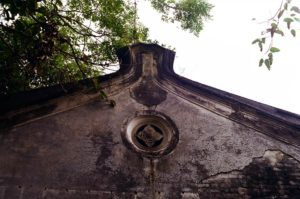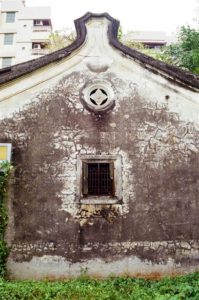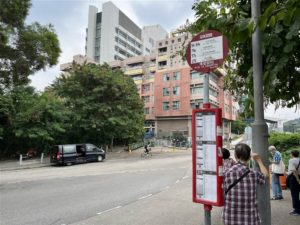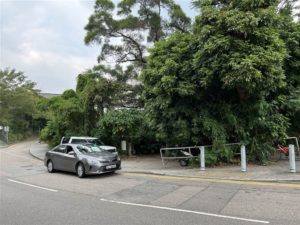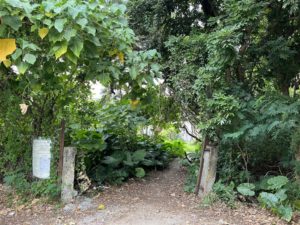The Yam Wah Lo (Pun Uk)

When visiting Hong Kong’s heritage sites, I find most of them to be very beautiful in their restored state. This visit at Yam Wah Lo, also known as Pun Uk, brought forth a different kind of appreciation. The unrestored historic Hakka structure, very much in ruins, stands in humility, strength and an aged authenticity. To say the least, it is no less beautiful, or perhaps in many ways even more so, than the restored monuments.

Photo: the first impression of Yam Wah Lo, Pun Uk
As I found the entrance to Yam Wah Lo, I saw the public notice posted on the left side of the gateway. The gist of the notice is that an application has been made for the conservation of the Pun Uk to the Planning Department. People are welcome to submit their comments to the same. Very soon, this aged authenticity that I saw on this day will become a thing of the past as well.
However, I am all for the restoration of the building. It will reinforce the structure, making it safe. Also, when the restoration finishes, visitors will be able to admire the inner halls and courtyards, as with all other historic buildings in Hong Kong. On this visit, I stopped at the entrance. All interiors were off-bound to visitors.
Pun Uk became a Grade 1 Historic Building in 2010.
There will be a day that a renewed glory adorns its mantle.

The History of Pun Uk
In 1932, Kwan-min Pun, a merchant of Hakka origin, built the Yam Wah Lo to commemorate his father Yam-wah Pun. The building was therefore named after his father. As a merchant, Kwan-min Pun has donated funds for both the 1911 Revolution and the Pok Oi Hospital. Because Kwan-min Pun was a respectable member of the community, his mansion was once host to history-making, exceptional guests.
He was friends with Chinese Communist Party leader Ye Jianying. When would-be Premier Zhou Enlai and Ye Jianying came to Hong Kong in 1938, they stayed at the Pun Uk. Furthermore, famous writer Guo Moruo has also lived here in 1939. Few of Hong Kong’s historic monuments can rival this history.
A site that also had ties with exceptional leaders of China is the Kat Hing Wai Village. The last emperors of the Song Dynasty found refuge there. The royal aunt of the last emperor of Song Dynasty married into this village.
Architectural Features of Pun Uk
The Faculty of Architecture of the University of Hong Kong has done a great introduction on the architectural features of Pun Uk. Since I only managed to see the outside of the mansion, I will keep this introduction brief.
Kwan-min Pun hired four craftsmen from hometown Meizhou to construct the Pun Uk. The house closely resembled the design of the Yam-wah Lo there. It was his ancestral home in China. The team sourced building materials from Foshan, Guangzhou and Shantou. It took two years before construction completed.
The layout of Pun Uk follows the traditional “two-hall, two-row” format, which is typical for the mansion style of Hakka dwellings. As the Faculty of Architecture’s website explains, the construction of Hakka architecture adheres to fengshui principles. It “emphasizes enclosure, centrality and symmetry.” This means that the halls, referring to the main halls lying on the central axis of the mansion, are strictly aligned in their layouts.
In Pun Uk, the entrance hall comes first, with the ancestral hall (with a worship altar) following in its main axis. On the other hand, the “two-row” refers to the auxiliary structures that lie in symmetry as they extend from the main axis. The mansion prides a total of 16 rooms, 6 main chambers and 2 courtyards.
Photos: on the left and right of the front door, identical chambers in perfect symmetry.
Originally, there was a pond in half-moon shape in front of the mansion. This echoes the woods, also in half-moon shape, behind the mansion. When I visited, I did not notice it because people have laid down large and unstable wooden boards to allow access to the building’s entrance.
The beams on the sides of the front porch show beautiful carvings. They depict scenes and items of auspiciousness in Chinese culture. Especially worthy of note are the lions.
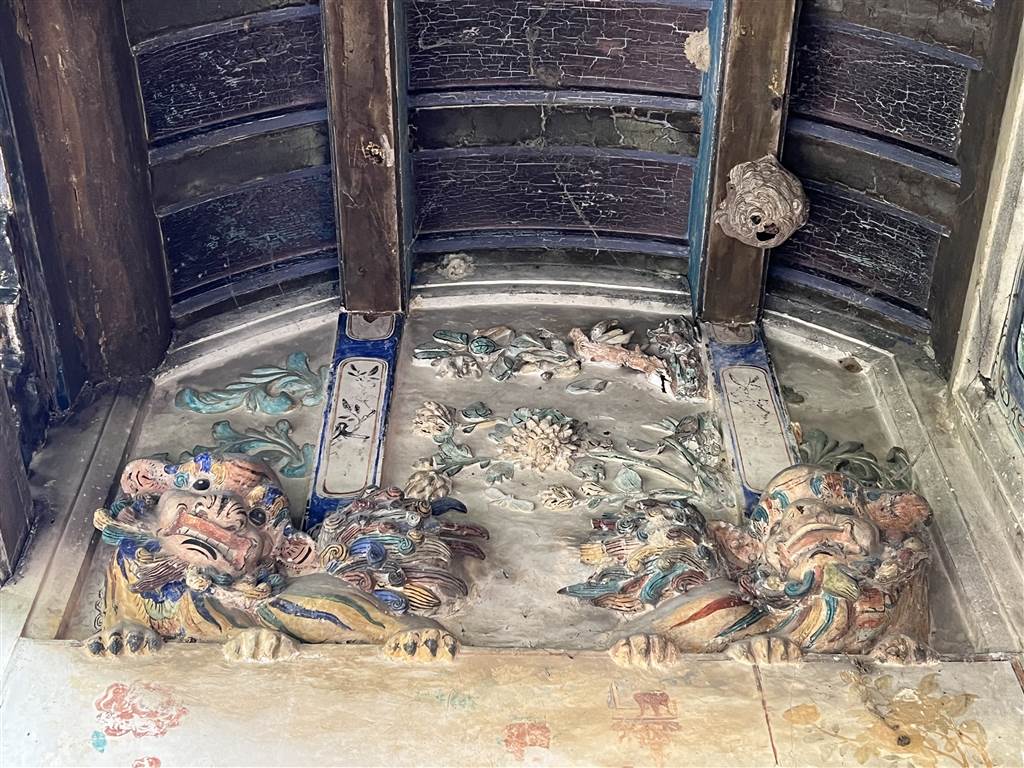
Photo: the glazed clay lions on the left beam remains. The details and the colors continue to breathe life into them.
There were originally 8 sculpted or glazed clay lions on the side beans at the front gate. Some were gold-plated. On this visit, I only saw the glazed clay lions on the left and right beams. At one point, people called Pun Uk “the Lion House” for this reason.

Photo: the side beams at the front door should have shown four gold-plated lions. But they are now gone.
I needed only about half an hour there, but the learning was priceless. Suffice to say, that even a cursory appreciation of the Pun Uk’s exterior would be worthwhile of a trip to Yuen Long. In fact, the Qing Dynasty Street of Yuen Long’s Old Market is just one bus stop away. I recommend doing both heritage visits in one go.
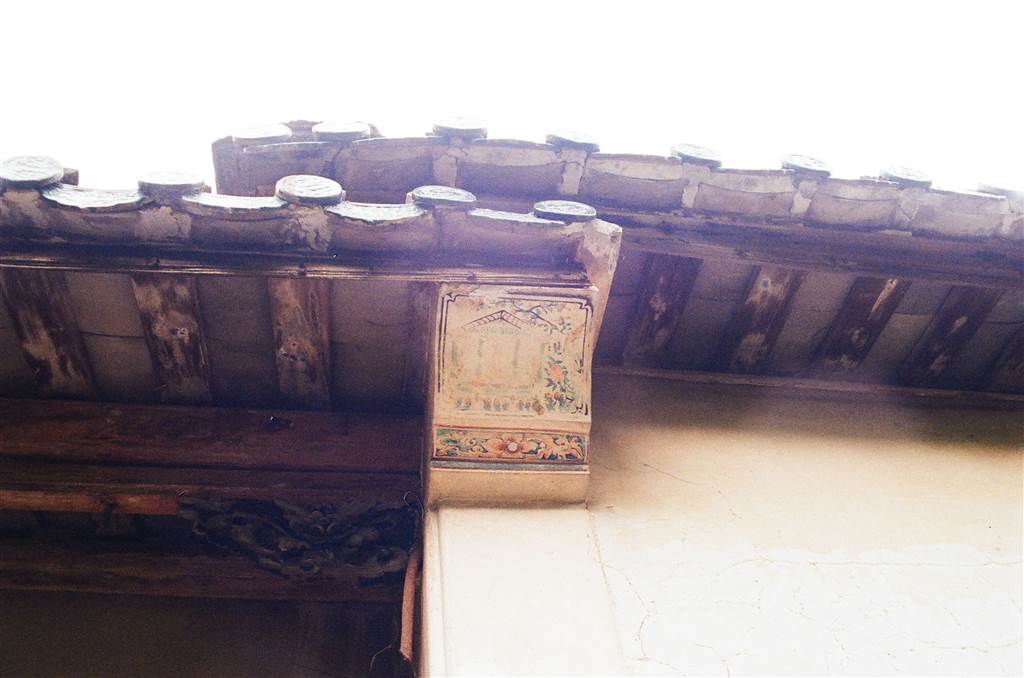
How to Get There
Many of the buses that run the Yuen Long area have a stop at the Pok Oi Hospital. The Yam Wah Lo is literally thirty seconds away from the bus stop. At the stop, look across you and you will see the entrance ahead. Cross the two roads, go straight. In this photo, the entrance is right by the two cars.
Photos: the photo on the left shows the Pok Oi Hospital Bus stop. The photo in the middle shows the entrance to Yam Wah Lo Pun Uk, it is right next to the two cars in this picture.
The photo on the right is a close-up of the entrance with the public notice on the left.
Sources
The University of Hong Kong, the Faculty of Architecture, Hands-On Heritage: Shared Conservation of a Historic Hakka Mansion.
Antiquities and Monuments Office, Assessment of 1,444 Historic Buildings.
The Wikipedia on Pun Uk (Chin).
The Wikipedia on Weilongwu (Chin).

